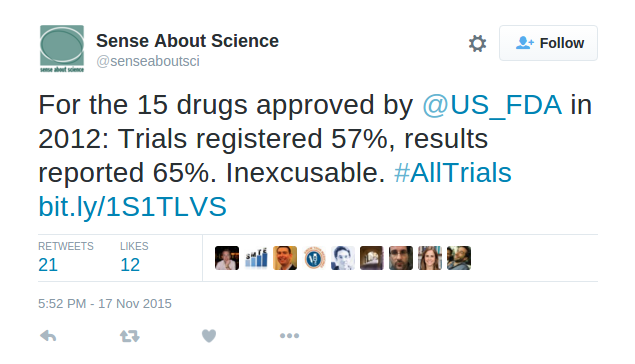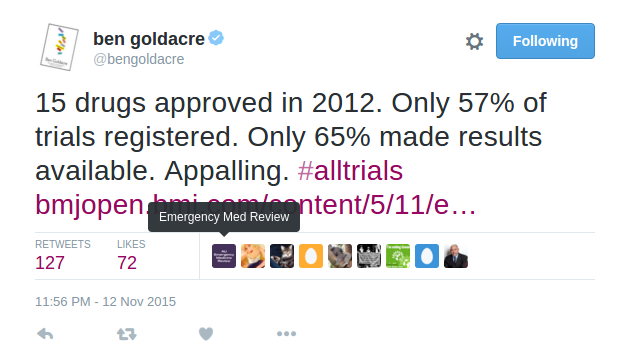If you thought you already had a good contender for “most dangerous, irresponsible, and ill-informed piece of health journalism of 2015”, then I’m sorry to tell you that it has been beaten into second place at the last minute.
With less than 36 hours left of 2015, I am confident that this article by Sarah Knapton in the Telegraph will win the title.
The article is titled “E-cigarettes are no safer than smoking tobacco, scientists warn”. The first paragraph is
“Vaping is no safer that [sic] smoking, scientists have warned after finding that e-cigarette vapour damages DNA in ways that could lead to cancer.”
There are such crushing levels of stupid in this article it’s hard to know where to start. But perhaps I’ll start by pointing out that a detailed review of the evidence on vaping by Public Health England, published earlier this year, concluded that e-cigarettes are about 95% less harmful than smoking.
If you dig into the detail of that review, you find that most of the residual 5% is the harm of nicotine addiction. It’s debatable whether that can really be called a harm, given that most people who vape are already addicted to nicotine as a result of years of smoking cigarettes.
But either way, the evidence shows that vaping, while it may not be 100% safe (though let’s remember that nothing is 100% safe: even teddy bears kill people), is considerably safer than smoking. This should not be a surprise. We have a pretty good understanding of what the toxic components of cigarette smoke are that cause all the damage, and most of those are either absent from e-cigarette vapour or present at much lower concentrations.
So the question of whether vaping is 100% safe is not the most relevant thing here. The question is whether it is safer than smoking. Nicotine addiction is hard to beat, and if a smoker finds it impossible to stop using nicotine, but can switch from smoking to vaping, then that is a good thing for that person’s health.
Now, nothing is ever set in stone in science. If new evidence comes along, we should always be prepared to revise our beliefs.
But obviously to go from a conclusion that vaping is 95% safer than smoking to concluding they are both equally harmful would require some pretty robust evidence, wouldn’t it?
So let’s look at the evidence Knapton uses as proof that all the previous estimates were wrong and vaping is in fact as harmful as smoking.
The paper it was based on is this one, published in the journal Oral Oncology. (Many thanks to for finding the link for me, which had defeated me after Knapton gave the wrong journal name in her article.)
The first thing to notice about this is that it is all lab based, using cell cultures, and so tells us little about what might actually happen in real humans. But the real kicker is that if we are going to compare vaping and smoking and conclude that they are as harmful as each other, then the cell cultures should have been exposed to equivalent amounts of e-cigarette vapour and cigarette smoke.
The paper describes how solutions were made by drawing either the vapour or smoke through cell media. We are then told that the cells were treated with the vaping medium every 3 days for up to 8 weeks. So presumably the cigarette medium was also applied every 3 days, right?
Well, no. Not exactly. This is what the paper says:
“Because of the high toxicity of cigarette smoke extract, cigarette-treated samples of each cell line could only be treated for 24 h.”
Yes, that’s right. The cigarette smoke was applied at a much lower intensity, because otherwise it killed the cells altogether. So how can you possibly conclude that vaping is no worse than smoking, when smoking is so harmful it kills the cells altogether and makes it impossible to do the experiment?
And yet despite that, the cigarettes still had a larger effect than the vaping. It is also odd that the results for cigarettes are not presented at all for some of the assays. I wonder if that’s because it had killed the cells and made the assays impossible? As primarily a clinical researcher, I’m not an expert in lab science, but not showing the results of your positive control seems odd to me.
But the paper still shows that the e-cigarette extract was harming cells, so that’s still a worry, right?
Well, there is the question of dose. It’s hard for me to know from the paper how realistic the doses were, as this is not my area of expertise, but the press release accompanying this paper (which may well be the only thing that Knapton actually read before writing her article) tells us the following:
“In this particular study, it was similar to someone smoking continuously for hours on end, so it’s a higher amount than would normally be delivered,”
Well, most things probably damage cells in culture if used at a high enough dose, so I don’t think this study really tells us much. All it tells us is that cigarettes do far more damage to cell cultures than e-cigarette vapour does. Because, and I can’t emphasise this point enough, THEY COULDN’T DO THE STUDY WITH EQUIVALENT DOSES OF CIGARETTE SMOKE BECAUSE IT KILLED ALL THE CELLS.
A charitable explanation of how Knapton could write such nonsense might be that she simply took the press release on trust (to be clear, the press release also makes the claim that vaping is as dangerous as smoking) and didn’t have time to check it. But leaving aside the question of whether a journalist on a major national newspaper should be regurgitating press releases without any kind of fact checking, I note that many people (myself included) have been pointing out to Knapton on Twitter that there are flaws in the article, and her response has been not to engage with such criticism, but to insist she is right and to block anyone who disagrees: the Twitter equivalent of the “la la la I’m not listening” argument.
It seems hard to come up with any explanation other than that Knapton likes to write a sensational headline and simply doesn’t care whether it’s true, or, more importantly, what harm the article may do.
And make no mistake: articles like this do have the potential to cause harm. It is perfectly clear that, whether or not vaping is completely safe, it is vastly safer than smoking. It would be a really bad outcome if smokers who were planning to switch to vaping read Knapton’s article and thought “oh, well if vaping is just as bad as smoking, maybe I won’t bother”. Maybe some of those smokers will then go on to die a horrible death of lung cancer, which could have been avoided had they switched to vaping.
Is Knapton really so ignorant that she doesn’t realise that is a possible consequence of her article, or does she not care?
And in case you doubt that anyone would really be foolish enough to believe such nonsense, I’m afraid there is evidence that people do believe it. According to a survey by Action on Smoking and Health (ASH), the proportion of people who believe that vaping is as harmful or more harmful than smoking increased from 14% in 2014 to 22% in 2015. And in the USA, the figures may be even worse: this study found 38% of respondents thought e-cigarettes were as harmful or more harmful than smoking. (Thanks again to for finding the links to the surveys.)
I’ll leave the last word to Deborah Arnott, Chief Executive of ASH:
“The number of ex-smokers who are staying off tobacco by using electronic cigarettes is growing, showing just what value they can have. But the number of people who wrongly believe that vaping is as harmful as smoking is worrying. The growth of this false perception risks discouraging many smokers from using electronic cigarettes to quit and keep them smoking instead which would be bad for their health and the health of those around them.”


